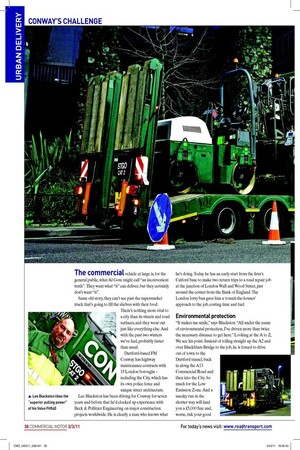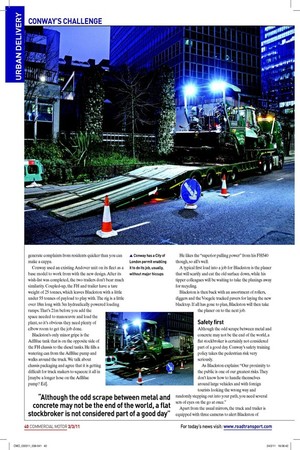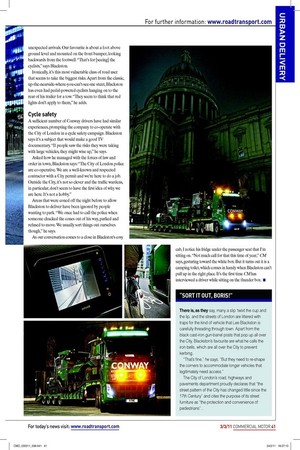The commercial vehicle at large is, for the general public,
Page 30

Page 31

Page 32

Page 33

If you've noticed an error in this article please click here to report it so we can fix it.
what Al Gore might call “an inconvenient truth”. They want what “it” can deliver, but they certainly don’t want “it”.
Same old story, they can’t see past the supermarket truck that’s going to ill the shelves with their food. There’s nothing more vital to a city than its streets and road surfaces, and they wear out just like everything else. And with the past two winters we’ve had, probably faster than usual.
Dartford-based FM Conway has highway maintenance contracts with 15 London boroughs – including the City, which has its own police force and unique street architecture.
Lee Blackston has been driving for Conway for seven years and before that he’d clocked up experience with Beck & Pollitzer Engineering on major construction projects worldwide. He is clearly a man who knows what he’s doing. Today he has an early start from the irm’s Catford base to make two return trips to a road repair job at the junction of London Wall and Wood Street, just around the corner from the Bank of England. The London lorry ban gave him a ‘round-the-houses’ approach to the job, costing time and fuel.
Environmental protection
“It makes me smile,” says Blackston. “All under the name of environmental protection, I’ve driven more than twice the necessary distance to get here.” Looking at the A to Z, We see his point. Instead of rolling straight up the A2 and over Blackfriars Bridge to the job, he is forced to drive out of town to the Dartford tunnel, back in along the A13 Commercial Road and then into the City. So much for the Low Emission Zone. And a sneaky run in the shorter way will land you a £5,000 ine and, worse, risk your good repute. “Maybe Boris needs a map in his ofice,” Blackston suggests.
As for the tools of his trade, Blackston is on board a Volvo FH540 6x4 tractor, with a 12-speed manual box, hitched to a bespoke four-axle step-frame beavertail from Andover Trailers. According to Blackston, putting three heads together has come up with the perfect tool for the job. Volvo’s Maidstone dealer, MC Truck & Bus, the Andover Trailers tech team and Conway’s plant buyers all spent time creating the tractor/trailer combination they needed to get their variety of road maintenance plant into the City with the minimum of fuss.
Their brief was to squeeze every inch of space for the varied loads and achieve the best possible geometry for tight turns on city streets – all while keeping the front of the trailer out of trouble, as well as the rear. Among crucial elements are the two steered BPW axles, the low-proile trailer neck and the raise/lower air suspension.
Safety and steerage
The front trailer axle lifts in conjunction with a lock on the third axle to get the best balance of safety and steerage. The usual forest of marker lights, lashing points, tool boxes and slide-out side extensions and a 16,000lb electric winch ill up the spec sheet. Keeping noise levels to a minimum is important too, so the trailer hydraulics are powered by an electric pump, not a PTO. A throbbing low-frequency diesel supplying power to auxiliaries will
generate complaints from residents quicker than you can ▲ Conway has a City of make a cuppa. London permit enabling Conway used an existing Andover unit on its leet as a it to do its job, usually, base model to work from with the new design. After its without major hiccups wish-list was completed, the two trailers don’t bear much
similarity. Coupled-up, the FH and trailer have a tare weight of 25 tonnes, which leaves Blackston with a little under 55 tonnes of payload to play with. The rig is a little over 18m long with 3m hydraulically powered loading ramps. That’s 21m before you add the space needed to manoeuvre and load the plant, so it’s obvious they need plenty of elbow room to get the job done.
Blackston’s only minor gripe is the AdBlue tank that is on the opposite side of the FH chassis to the diesel tanks. He ills a watering can from the AdBlue pump and walks around the truck. We talk about chassis packaging and agree that it is getting dificult for truck makers to squeeze it all in [maybe a longer hose on the AdBlue pump? Ed]. He likes the “superior pulling power” from his FH540 though, so all’s well.
A typical irst load into a job for Blackston is the planer that will scarify and cut the old surface down, while his tipper colleagues will be waiting to take the planings away for recycling.
Blackston is then back with an assortment of rollers, diggers and the Voegele tracked pavers for laying the new blacktop. If all has gone to plan, Blackston will then take the planer on to the next job.
Safety first
Although the odd scrape between metal and concrete may not be the end of the world, a lat stockbroker is certainly not considered part of a good day. Conway’s safety training policy takes the pedestrian risk very seriously.
As Blackston explains: “Our proximity to the public is one of our greatest risks. They don’t know how to handle themselves around large vehicles and with foreign tourists looking the wrong way and randomly stepping out into your path, you need several sets of eyes on the go at once.” Apart from the usual mirrors, the truck and trailer is equipped with three cameras to alert Blackston of unexpected arrivals. Our favourite is about a foot above ground level and mounted on the front bumper, looking backwards from the footwell. “That’s for [seeing] the cyclists,” says Blackston.
Ironically, it’s this most vulnerable class of road user that seems to take the biggest risks. Apart from the classic, up-the-nearside-where-you-can’t-see-me stunt, Blackston has even had pedal-powered cyclists hanging on to the rear of his trailer for a tow. “They seem to think that red lights don’t apply to them,” he adds.
Cycle safety
A suficient number of Conway drivers have had similar experiences, prompting the company to co-operate with the City of London in a cycle safety campaign. Blackston says it’s a subject that would make a good TV documentary. “If people saw the risks they were taking with large vehicles, they might wise up,” he says.
Asked how he managed with the forces of law and order in town, Blackston says: “The City of London police are co-operative. We are a well-known and respected contractor with a City permit and we’re here to do a job. Outside the City, it’s not so clever and the trafic wardens, in particular, don’t seem to have the irst idea of why we are here. It’s not a hobby.” Areas that were coned off the night before to allow Blackston to deliver have been ignored by people wanting to park. “We once had to call the police when someone chucked the cones out of his way, parked and refused to move. We usually sort things out ourselves though,” he says.
As our conversation comes to a close in Blackston’s cosy
cab, I notice his fridge under the passenger seat that I’m sitting on. “Not much call for that this time of year,” CM says, gesturing toward the white box. But it turns out it is a camping toilet, which comes in handy when Blackston can’t pull up in the right place. It’s the irst time CM has interviewed a driver while sitting on the thunder box. ■



















































